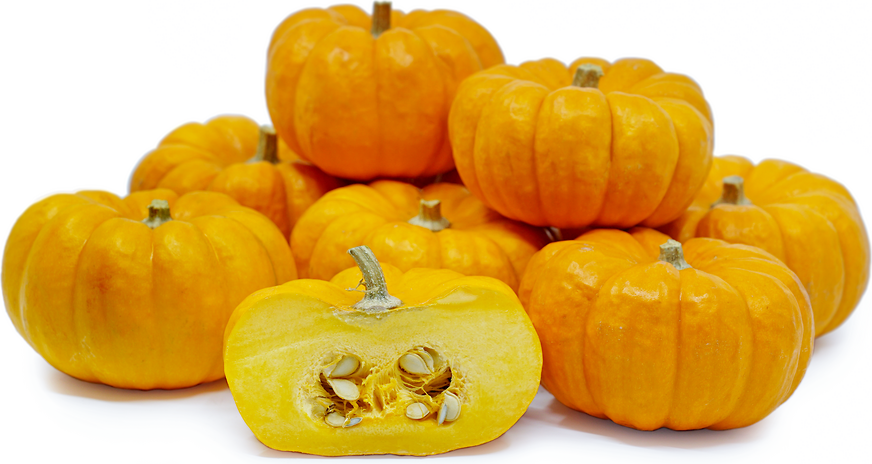


Mini Pumpkins
Estimated Inventory, 40 ct : 0
This item was last sold on : 11/26/24
Description/Taste
Mini pumpkins are characterized by their compact size, usually measuring 7.5 to 10 centimeters in diameter, 5 to 6.5 centimeters in height, and weighing between 170 and 340 grams. These pumpkins often have a squat, round, and flattened shape with a small, light brown-grey stem. Their rind can be orange or ivory and is typically deeply ribbed, firm, and glossy, featuring a mostly smooth texture with some bumps and irregularities. Some varieties of Mini pumpkins have a more circular structure that lacks ribbing but has faint spaced-out lines running from the top to the bottom of the fruit. The thick flesh of Mini pumpkins makes up a significant portion of their form. This flesh has a pale orange-yellow color and is dense and moist, encasing a small central cavity with fibrous pulp and flat, cream-colored seeds. When cooked, Mini pumpkins are tender and smooth with a mild, slightly sweet taste.
Seasons/Availability
Mini pumpkins are available from fall to winter.
Current Facts
Mini pumpkins are botanically classified as Cucurbita pepo. They are miniature fruits that grow on compact vines and are members of the Cucurbitaceae family along with gourds and squash. Mini pumpkins are botanically regarded as a type of gourd rather than a pumpkin. There are many different varieties, including well-known ones like Jack Be Little, Baby Bear, and Wee Be Little pumpkins. These varieties are predominately ornamental and commonly used as table decorations but can also be implemented into a variety of culinary applications. Mini pumpkins are favored by home gardeners for their ability to grow in compact spaces, creeping along trellises and fences, with vines that may reach up to a meter long.
Nutritional Value
Mini pumpkins have most of the same nutrients as larger sized pumpkins but in smaller amounts. They are particularly rich in vitamin A, which is vital for eye health, immune function, and skin regeneration. They also contain vitamin C, an antioxidant that boosts immunity and promotes collagen production, iron absorption, and supports skin health, as well as vitamin E, which protects cells from oxidative damage, prevents bad cholesterol, reduces inflammation, and improves cellular function. Mini pumpkins are a source of riboflavin and potassium, aiding in energy production, nerve and muscle function, blood pressure regulation, and fluid balance. These fruits supply copper, manganese, and thiamin, nutrients essential for red blood cell production, bone health, metabolism, converting carbohydrates into energy, and supporting the nervous system.
Applications
Mini pumpkins are best suited for cooked applications such as baking or roasting. When the top is sliced off and the pulp and seeds are removed, these pumpkins can be roasted on their own or stuffed and baked. As a serving bowl, they’re often selected for savory dishes such as curries and soups like pumpkin tortilla or pomegranate lentil. They may also be stuffed with sausage and kale or blended grains and roasted vegetables. Mini pumpkins can serve as a ramekin for custards, pumpkin pies, crème brulee, apple crisps, or pumpkin cheesecakes. They pair well with black beans, quinoa, couscous, Brussels sprouts, cauliflower, mushrooms, garlic, red and green onions, currants, pine nuts, cinnamon, sage, and thyme. They will keep for 6 to 12 months when stored in a cool, dry place.
Ethnic/Cultural Info
Mini pumpkins are one of many pumpkin varieties that have become a staple of fall décor in the United States. Their rise in popularity began after World War II when the end of sugar rationing and the growth in popularity of trick-or-treating transitioned these fruits from a valued culinary crop to a decorative icon. People needed something to adorn their porches, and jack-o’-lanterns filled that role. Over time, pumpkins were bred for durability, shape, and uniform size, with taste becoming less of a priority. Today, Mini pumpkins are commonly seen in fall displays where they're often arranged with other squashes and gourds. They are also frequently used in various DIY projects. Mini pumpkins can be hollowed out to hold candles as votives, used as vases for flowers, or left whole and decorated with paint and pens to serve as name placards for dinner tables.
Geography/History
The origins of Mini pumpkins are not widely known, but they likely date back to the early cultivation of pumpkins, which originated in the region stretching from the Southwestern United States through Mexico, Central America, and parts of South America, including Peru, Ecuador, and Colombia, around 2500 BCE. They thrive in warm and subtropical climates with full sun exposure and rich soils. These small fruits are cultivated commercially and in home gardens for their petite stature. Miniature pumpkins began to gain popularity in the mid to late 20th century as novelty varieties became a favored choice for fall decor. Among these, the well-known miniature variety Jack Be Little was developed in the late 1980s by Hollar Seed Company in Rocky Ford, Colorado. Mini pumpkins may be purchased from seeds to grow in gardens or sold at farms, farmers’ markets, or grocery stores during the fall in the United States, Canada, Japan, New Zealand, and Mexico.
Recipe Ideas
Recipes that include Mini Pumpkins. One















